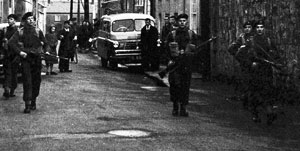5 April 2007 Edition
The Resistance Campaign 50 years on

A British Army patrol in Enniskillen during the Border Campaign
British reinforcements sent in
This week Mícheál MacDonncha continues a monthly series marking the 50th anniversary of the IRA’s Resistance Campaign – more widely known as the Border Campaign – which commenced in December 1956. The series will be based on the monthly republican newspaper of the time An tÉireannach Aontaithe/The United Irishman.
As Irish Republicans marked Easter 1957 the British Army was sending reinforcements into the Six Counties in response to the IRA’s campaign which had commenced the previous December. The troops came from deployment in some of Britain’s other colonies and were soon seen side by side with the RUC and B Specials.
The British Army propaganda of the time gives an early example of the use of the term ‘terrorism’ to describe the resistance of those fighting colonialism. A British Army publication stated:
“For troops who had fought terrorism on varying fronts, in Cyprus, Egypt and Kenya, it was an odd experience to be going through the same security routine on the soil of the United Kingdom.”
Among the regiments sent to Ireland were the 1st Battalion of the Warwickshire Regiment which had recently returned from Cyprus and in 1953 had been part of the British garrison in Egypt. The 1st Battalion of the Northumberland Fusiliers had been in Kenya where the British brutally suppressed the population during the 1950s. Over 300,000 people were held in British concentration camps in Kenya and torture and mutilation were commonplace.
The new Director of British Army Operations in the Six Counties was Brigadier O.G. Brooke who had been in Egypt and had commanded the SAS in Malaya (now Myanmar). British atrocities in Malaya in the 1950s were widespread and included the decapitation of alleged insurgents.
As the reinforcements were sent in the British government also confirmed that it would pay the bill for damage caused in the Six Counties by IRA attacks. This was despite the fact that in theory, under the 1920 Government of Ireland Act, the Stormont government was supposed to make an ‘Imperial Contribution’ to pay for the British military based in the North and other ‘services’ rendered by the British government. In effect this payment was not made and the Orange state was heavily subsidised by the British exchequer.
The United Irishman reported increased attendances at Easter commemorations throughout the country. It emphasised the parades held in the Six Counties, despite Stormont’s suppression of Sinn Féin and the ban on the flying of the Tricolour. 5,000 marched in Newry behind the banned Tricolour. Another item in the paper pointed out that the predominantly nationalist town had an unemployment rate of 25%. RUC photographers in plain clothes were identified at the Belfast parade where the oration was delivered by Séamus (Jimmy) Steele.
John Joe Rice, one of the four Sinn Féin TDs elected to Leinster House in March, spoke in Dublin’s Glasnevin Cemetery. He said the radio and press were “continually dinning imperialism into the ears of the younger generation”. Seán Cronin, one of the architects of the Border campaign, spoke in Leitrim while Sligo-Leitrim Sinn Féin TD John Joe McGirl spoke at Foxhall, Co. Longford.
Increasing numbers of republicans were appearing before the courts. At Letterkenny District Court Gerald McCarthy, Patrick Joseph Dawson, Seán Lynch, Vincent Conlon and Larry Bateson were sentenced to three months on arms charges. “Sending men to jail will not finish or stop the fight for Irish freedom”, stated McCarthy in court. Hugh Brady of Lurgan, Joe Campbell of Newry and Leo McCormack of Dublin finished a prison term in Belfast Prison and were immediately interned in the same prison.
A public reception was held in Castleconnell, Co. Limerick to welcome home Seán Edmonds who had been released from Mountjoy. Edmonds was Deputy Editor of The Tipperary Star newspaper and returned to that position after his imprisonment. He was later the author of the book The Gun, the Law and the Irish People.


